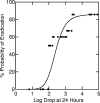Vancomycin in vitro bactericidal activity and its relationship to efficacy in clearance of methicillin-resistant Staphylococcus aureus bacteremia
- PMID: 17452488
- PMCID: PMC1913284
- DOI: 10.1128/AAC.00939-06
Vancomycin in vitro bactericidal activity and its relationship to efficacy in clearance of methicillin-resistant Staphylococcus aureus bacteremia
Abstract
We examined the relationship between the time to clearance of methicillin-resistant Staphylococcus aureus (MRSA) bacteremia while patients were receiving vancomycin therapy and the in vitro bactericidal activity of vancomycin. Vancomycin killing assays were performed with 34 MRSA bloodstream isolates (17 accessory gene regulator group II [agr-II] and 17 non-agr-II isolates) from 34 different patients with MRSA bacteremia for whom clinical and microbiological outcomes data were available. Vancomycin doses were prospectively adjusted to achieve peak plasma concentrations of 28 to 32 mug/ml and trough concentrations of 8 to 12 microg/ml. Bactericidal assays were performed over 24 h with approximately 10(7) to 10(8) CFU/ml in broth containing 16 microg/ml vancomycin. The median time to clearance of bacteremia was 6.5 days for patients with MRSA isolates demonstrating > or =2.5 reductions in log(10) CFU/ml at 24 h and >10.5 days for patients with MRSA isolates demonstrating <2.5 log(10) CFU/ml by 24 h (P = 0.025). The median time to clearance was significantly longer with MRSA isolates with vancomycin MICs of 2.0 microg/ml compared to that with MRSA isolates with MICs of < or =1.0 microg/ml (P = 0.019). The bacteremia caused by MRSA isolates with absent or severely reduced delta-hemolysin expression was of a longer duration of bacteremia (10 days and 6.5 days, respectively; P = 0.27) and had a decreased probability of eradication (44% and 78%, respectively; P = 0.086). We conclude that strain-specific microbiological features of MRSA, such as increased vancomycin MICs and decreased killing by vancomycin, appear to be predictive of prolonged MRSA bacteremia while patients are receiving vancomycin therapy. Prolonged bacteremia and decreased delta-hemolysin expression may also be related. Evaluation of these properties may be useful in the consideration of antimicrobial therapies that can be used as alternatives to vancomycin for the treatment of MRSA bacteremia.
Figures


References
-
- Clinical and Laboratory Standards Institute. 2006. Methods for dilution antimicrobial susceptibility tests for bacteria that grow aerobically; approved standard, 7th ed. CLSI document M7-A7. Clinical and Laboratory Standards Institute, Wayne, PA.
-
- Cosgrove, S. E., Y. Qi, K. S. Kaye, S. Harbarth, A. W. Karchmer, and Y. Carmeli. 2005. The impact of methicillin resistance in Staphylococcus aureus bacteremia on patient outcomes: mortality, length of stay, and hospital charges. Infect. Control Hosp. Epidemiol. 26166-174. - PubMed
-
- Cosgrove, S. E., G. Sakoulas, E. N. Perencevich, M. J. Schwaber, A. W. Karchmer, and Y. Carmeli. 2003. Comparison of mortality associated with methicillin-resistant and methicillin-susceptible Staphylococcus aureus bacteremia: a meta-analysis. Clin. Infect. Dis. 3653-59. - PubMed
-
- Denny, A. E., L. R. Peterson, D. N. Gerding, and W. H. Hall. 1979. Serious staphylococcal infections with strains tolerant to bactericidal antibiotics. Arch. Intern. Med. 1391026-1031. - PubMed
Publication types
MeSH terms
Substances
LinkOut - more resources
Full Text Sources
Medical

